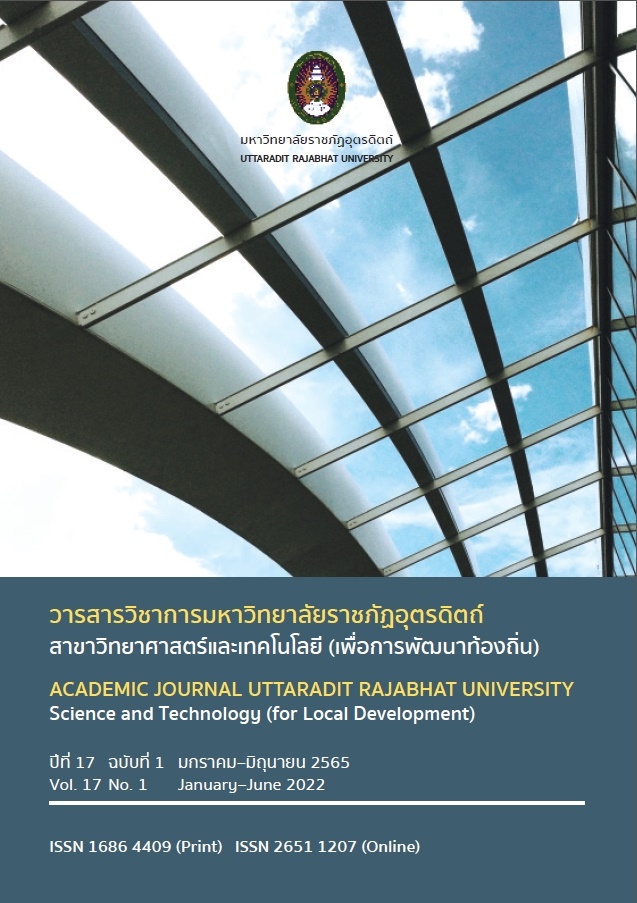THE APPLICATIONS OF MULTILEVEL STRUCTURAL EQUATION MODELING IN PUBLIC HEALTH SURVEY
Main Article Content
Abstract
This article shows that the application of concept of public health survey of health conditions using Multilevel Structural Equation Model (MSEM) with health survey. MSEM was chosen in order to be farsighted the digital disrupted and pandemic of coronavirus-19 disease among the change of technology, health survey with new normal that these have been little and unclear. This study was to the explained of individual-between levels, and strength/weakness of MSEM in public health survey. Methods: Public health survey was chosen in order to handle data transformation.
The results showed that MSEM at the individual level is determined by public health survey about at 50- 100 groups, and the between level is determined by the health facilities about 450-9800 peoples. The performance on MSEM showed improvement, especially on the efficiency of the new modeling needed for digital disruptions. It helped to reduce the complexity in health conditions. MSEM have performed the prevention and control of pandemics, all health behaviors, quality of life, life expectancy, cancer, chronic diseases, occupation health and safety. These should also be applied to the public health survey for the novel of performance variables, the body of knowledge, the application among active surveillance in digital disruption.
Downloads
Article Details

This work is licensed under a Creative Commons Attribution-NonCommercial-NoDerivatives 4.0 International License.
References
Brown, T. A. (2015). Confirmatory Factor Analysis for Applied Research. London: Guilford.
Cheung, M. W. L., & Au, K. (2005). Applications of Multilevel Structural Equation Modeling to Cross-Cultural Research. Structural Equation Modeling: A Multidisciplinary Journal, 12(4), 598–619.
Davidov, E., Duelmer, H., Schlüter, E., Schmidt, P., & Meuleman, B. (2012). Using a Multilevel Structural Equation Modeling Approach to Explain Cross-Cultural Measurement Noninvariance. Journal of Cross-Cultural Psychology – J CROSS-CULT PSYCHOL, 43, 558–575.
De Vet, H. C., Terwee, C. B., Mokkink, L. B., & Knol, D. L. (2011). Measurement in Medicine: A Practical Guide. London: Cambridge University Press.
Hox, J. J. (2013). Multilevel Regression and Multilevel Structural Equation Modeling. In T. D. Little (Ed.), The Oxford Handbook of uantitative Methods, (pp. 281–294). New York: Oxford University Press.
Hox, J. J., & Maas, C. J. (2001). The Accuracy of Multilevel Structural Equation Modeling with Pseudo Balanced Groups and Small Samples. Structural Equation Modeling, 8(2), 157–174.
Hox, J. J., Maas, C. J., & Brinkhuis, M. J. (2010). The Effect of Estimation Method and Sample Size in Multilevel Structural Equation Modeling. Statistica Neerlandica, 64(2), 157–170.
Hsu, H. Y., Lin, J. J. H., Skidmore, S. T., & Kim, M. (2019). Evaluating Fit Indices in a Multilevel Latent Growth Curve Model: A Monte Carlo Study. Behav Res Methods, 51(1), 172–194.
Jannaksan, S. (2020). The Principle of Multilevel Structural Equation Modeling Analysis by Using Optimal Sample Size and Estimation Methods. Journal of Social Sciences in Measurement Evaluation Statistics and Research, 1(1), 12–20.
Maggino, F., & Zumbo, B. D. (2012). Measuring the Quality of Life and the Construction of Social Indicators. In K. C. Land, A. C. Michalos, & M. J. Sirgy (Eds.), Handbook of Social Indicators and Quality-of-Life Research, (pp. 201–238). Dordrecht, Netherlands: Springer.
Marsh, H. W., Hau, K.-T., & Wen, Z. (2004). In Search of Golden Rules: Comment on Hypothesis-Testing Approaches to Setting Cutoff Values for Fit Indexes and Dangers in Overgeneralizing Hu and Bentler’s (1999) Findings. Structural Equation Modeling: A Multidisciplinary Journal, 11(3), 320–341.
Muthén, B. (2011). Applications of Causally Defined Direct and Indirect Effects in Mediation Analysis Using SEM in Mplus. Los Angeles: Mplus Citation.
Muthén, L. K., & Muthén, B. O. (1998). Mplus User’s Guide (Version 7). Los Angeles: CA Citation.
Preacher, K. J. (2011). Multilevel SEM Strategies for Evaluating Mediation in Three-level Data. Multivariate Behavioral Research, 46(4), 691–731.
Rabe-Hesketh, S., & Skrondal, A. (2006). Multilevel Modelling of Complex Survey Data. Journal of the Royal Statistical Society: Series A (Statistics in Society), 169(4), 805–827.
Rabe-Hesketh, S., & Skrondal, A. (2008). Multilevel and Longitudinal Modeling Using Stata. Statistical Methods in Medical Research, 17(1), 5–32.
Ryu, E. (2014). Model Fit Evaluation in Multilevel Structural Equation Models. Frontiers in Psychology, 5, 81.
Saengtrakul, K., Kanjanawasee, S., & Wiratchai, N. (2016). Student Factors Affecting Latent Transition of Mathematics Achievement Measuring from Latent Transition Analysis with a Mixture Item Response Theory Measurement Model. Procedia – Social and Behavioral Sciences, 217, 729–737.
Sinjindawong, S. (2008). Multi-Level Causal Model: Application for Data Analysis. Rajabhat Suratthani University Journal, 1(2), 45–58.
Strong, C., Ji, C. S., Liang, W., Ma, G., Brown, R., & Wang, J. H. (2014). Heterogeneous Demographic and Cultural Profiles of Chinese American Patients Nonadherent to Colorectal Cancer Screening: A Latent Class Analysis. Cancer Nurs, 37(2), 106–113.
Temporin, F. (2019). A Multilevel Structural Equation Modelling Approach to Study Segregation of Deprivation: An Application to Bolivia. Quality & Quantity, 53(3), 1657–1674.

